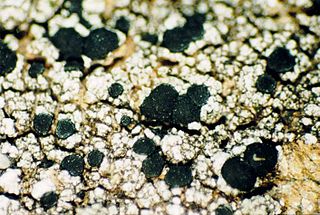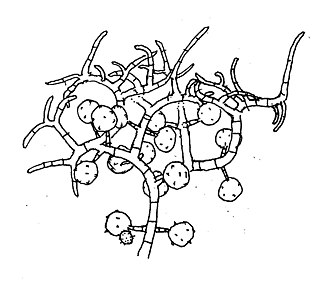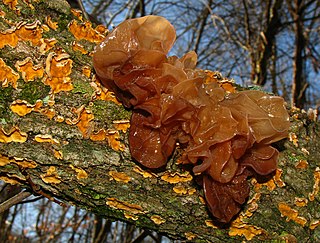
Brain abscess is an abscess caused by inflammation and collection of infected material, coming from local or remote infectious sources, within the brain tissue. The infection may also be introduced through a skull fracture following a head trauma or surgical procedures. Brain abscess is usually associated with congenital heart disease in young children. It may occur at any age but is most frequent in the third decade of life.

Rusts are plant diseases caused by pathogenic fungi of the order Pucciniales.

Zygomycota, or zygote fungi, is a former division or phylum of the kingdom Fungi. The members are now part of two phyla the Mucoromycota and Zoopagomycota. Approximately 1060 species are known. They are mostly terrestrial in habitat, living in soil or on decaying plant or animal material. Some are parasites of plants, insects, and small animals, while others form symbiotic relationships with plants. Zygomycete hyphae may be coenocytic, forming septa only where gametes are formed or to wall off dead hyphae. Zygomycota is no longer recognised as it was not believed to be truly monophyletic.

An entomopathogenic fungus is a fungus that can act as a parasite of insects and kills or seriously disables them.

The Mucorales is the largest and best studied order of zygomycete fungi. Members of this order are sometimes called pin molds. The term mucormycosis is now preferred for infections caused by molds belonging to the order Mucorales.

A parasitic plant is a plant that derives some or all of its nutritional requirements from another living plant. They make up about 1% of angiosperms and are found in almost every biome. All parasitic plants have modified roots, called haustoria, which penetrate the host plant, connecting them to the conductive system – either the xylem, the phloem, or both. For example, plants like Striga or Rhinanthus connect only to the xylem, via xylem bridges (xylem-feeding). Alternately, plants like Cuscuta and Orobanche connect only to the phloem of the host (phloem-feeding). This provides them with the ability to extract water and nutrients from the host. Parasitic plants are classified depending on the location where the parasitic plant latches onto the host and the amount of nutrients it requires. Some parasitic plants can locate their host plants by detecting chemicals in the air or soil given off by host shoots or roots, respectively. About 4,500 species of parasitic plants in approximately 20 families of flowering plants are known.

The Mucoraceae are a family of fungi of the order Mucorales, characterized by having the thallus not segmented or ramified. Pathogenic genera include Absidia, Apophysomyces, Mucor, Rhizomucor, and Rhizopus. According to a 2008 estimate, the family contains 25 genera and 129 species.

The Cunninghamellaceae are a family of fungi in the order Mucorales.

The Lecanoraceae are a family of lichenized fungi in the order Lecanorales. Species of this family have a widespread distribution.

The Choanephoraceae are a family of fungi in the order Mucorales. Members of this family are found mostly in the tropics or subtropics, and only rarely in temperate zones. The family currently includes species formerly classified in the family Gilbertellaceae.

The Zoopagomycotina are a subdivision of the fungal division Zygomycota sensu lato. It contains 5 families and 20 genera. Relationships among and within subphyla of Zygomycota are poorly understood, and their monophyly remains in question, so they are sometimes referred to by the informal name zygomycetes.

Mucoromycotina is a subphylum of uncertain placement in Fungi. It was considered part of the phylum Zygomycota, but recent phylogenetic studies have shown that it was polyphyletic and thus split into several groups, it is now thought to be a paraphyletic grouping. Mucoromycotina is currently composed of 3 orders, 61 genera, and 325 species. Some common characteristics seen throughout the species include: development of coenocytic mycelium, saprotrophic lifestyles, and filamentous.

The Mortierellaceae are a family of fungi in the order Mortierellales. The family contains six genera and 93 species.
Filobasidium is a genus of fungi in the family Filobasidiaceae. Most species are only known from their yeast states, but some produce hyphae with haustorial cells, indicating that they are parasites of other fungi. Basidia are tubular with terminal, sessile basidiospores. Basidiocarps are not formed.
Bulleribasidium is a genus of fungi in the family Bulleribasidiaceae. The genus currently contains some eleven species. The type species is a parasite of other fungi, its teleomorph having septate basidia and haustorial cells on its hyphae that connect to the host hyphae. Most species are, however, only known from their yeast states.

The Sigmoideomycetaceae are a family of fungi in the Zoopagales order. The family contain contains three genera, and six species. The family was circumscribed in 1992.

Coleosporium is a genus of rust fungi in the family Coleosporiaceae. The genus contains about 100 species. The aecial stages are parasitic on Pinus spp., and the telial stages on a wide range of angiosperms.

Syzygites is a monotypic genus in Zygomycota. The sole described species is Syzygites megalocarpus, which was the first fungus for which sex was reported and the main homothallic representative in the research that allowed for the classification of fungi as homothallic or heterothallic. It is also the fungus from which the term "zygospore" was coined.
Lichtheimiaceae is a family of fungi in the order Mucorales. The family was circumscribed in 2013 after a molecular phylogenetic analysis helped delineate a new family structure for the Mucorales.

Phaeotremella frondosa is a species of fungus in the family Phaeotremellaceae producing brownish, frondose, gelatinous basidiocarps. It is widespread in north temperate regions, and is parasitic on other species of fungi that grow on dead attached and recently fallen branches of broadleaf trees.

















